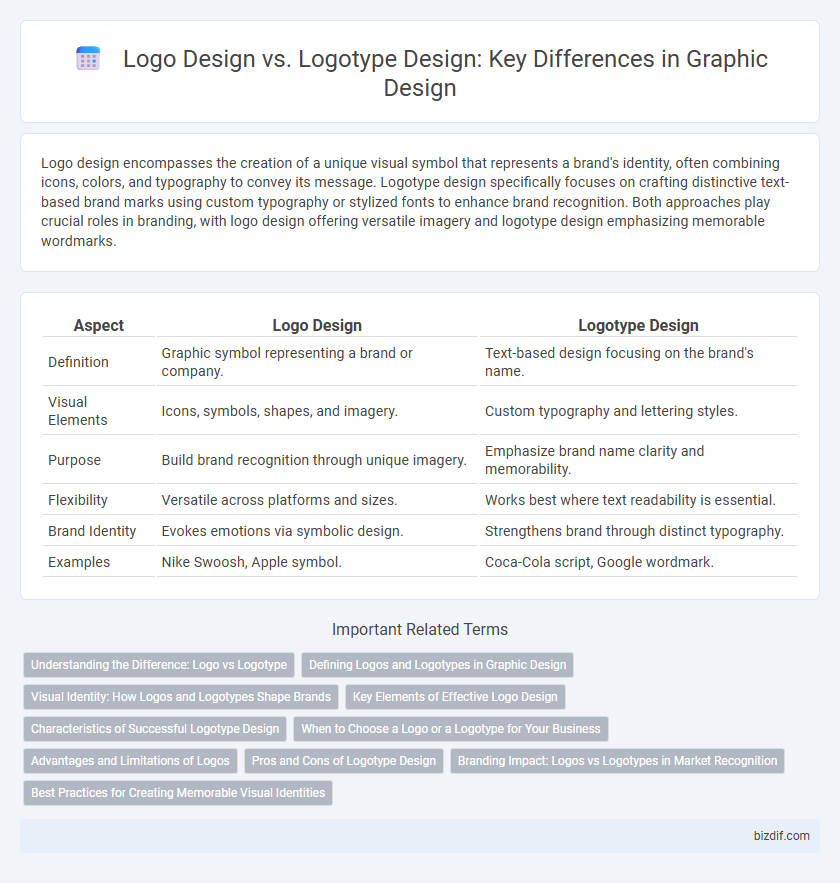Logo design encompasses the creation of a unique visual symbol that represents a brand's identity, often combining icons, colors, and typography to convey its message. Logotype design specifically focuses on crafting distinctive text-based brand marks using custom typography or stylized fonts to enhance brand recognition. Both approaches play crucial roles in branding, with logo design offering versatile imagery and logotype design emphasizing memorable wordmarks.
Table of Comparison
| Aspect | Logo Design | Logotype Design |
|---|---|---|
| Definition | Graphic symbol representing a brand or company. | Text-based design focusing on the brand's name. |
| Visual Elements | Icons, symbols, shapes, and imagery. | Custom typography and lettering styles. |
| Purpose | Build brand recognition through unique imagery. | Emphasize brand name clarity and memorability. |
| Flexibility | Versatile across platforms and sizes. | Works best where text readability is essential. |
| Brand Identity | Evokes emotions via symbolic design. | Strengthens brand through distinct typography. |
| Examples | Nike Swoosh, Apple symbol. | Coca-Cola script, Google wordmark. |
Understanding the Difference: Logo vs Logotype
Logo design encompasses creating visual symbols that represent a brand, including icons, marks, and graphic elements, while logotype design specifically involves crafting custom typography that spells out the brand name. Understanding the difference helps in choosing the right approach to brand identity, where logos focus on memorable imagery and logotypes emphasize distinctive letterforms. Both play crucial roles in graphic design by enhancing brand recognition through either symbolic visuals or typographic style.
Defining Logos and Logotypes in Graphic Design
Logos in graphic design encompass symbols, icons, or emblems representing a brand's identity, often combining both visual imagery and text for versatile recognition. Logotypes specifically refer to text-based logo designs where the brand's name is stylized through unique typography to convey the brand's personality. Differentiating between logos and logotypes is crucial for designers to select the appropriate branding strategy that aligns with company values and target audience perception.
Visual Identity: How Logos and Logotypes Shape Brands
Logo design creates a distinct visual symbol that encapsulates a brand's identity, emphasizing shape, color, and imagery to evoke instant recognition. Logotype design focuses on custom typography and letterform manipulation to communicate a brand's personality and values through text alone. Both approaches critically influence visual identity by reinforcing brand consistency and enabling emotional connection with target audiences.
Key Elements of Effective Logo Design
Effective logo design hinges on simplicity, memorability, and versatility, ensuring that the visual mark remains clear across diverse applications and sizes. Logotype design emphasizes unique typography and custom lettering, reinforcing brand identity through distinct, readable text that resonates with the target audience. Both approaches require a strategic balance of color psychology, scalability, and brand relevance to create an impactful and enduring brand symbol.
Characteristics of Successful Logotype Design
Successful logotype design features distinct typography that clearly conveys brand identity while maintaining legibility across various sizes and mediums. Effective logotypes balance simplicity and uniqueness, ensuring instant recognition and versatility in digital and print applications. Consistent use of color schemes and spacing further enhances memorability and fosters strong brand association.
When to Choose a Logo or a Logotype for Your Business
Choosing between a logo and a logotype depends on your brand identity and communication goals. Logos use symbols or icons to create visual recognition, making them ideal for businesses seeking a strong, memorable image that transcends language. Logotypes emphasize typography and are effective when your brand name is unique and needs clear presentation to build name recognition and convey professionalism.
Advantages and Limitations of Logos
Logos offer immediate visual recognition and can convey brand values through unique symbols, making them highly versatile across various marketing materials. Their advantages include strong memorability and the ability to create emotional connections, while limitations involve potential cultural misinterpretations and reduced clarity at small sizes. Unlike logotype designs, logos may require supplementary text for brand identification, which can affect simplicity and scalability.
Pros and Cons of Logotype Design
Logotype design, which centers on using stylized text to create a distinctive brand identity, offers the advantage of immediate brand name recognition and versatility across mediums. Its main drawback lies in limited visual symbolism, potentially reducing memorability compared to logo marks or symbols. However, logotypes excel in conveying professionalism and clarity, especially for brands aiming to highlight their name without accompanying graphic elements.
Branding Impact: Logos vs Logotypes in Market Recognition
Logo design encompasses a broad range of visual marks that represent a brand, including symbols, icons, and abstract graphics, while logotype design specifically refers to typographic treatments of a brand's name. Logotypes often enhance brand recognition by creating distinct, memorable wordmarks that communicate personality and style directly through customized fonts and lettering. In market recognition, combining logos with logotypes can strengthen branding impact by merging symbolic imagery with clear textual identity, increasing consumer recall and differentiation.
Best Practices for Creating Memorable Visual Identities
Logo design emphasizes creating a unique symbol or icon that represents brand values, while logotype design focuses on stylized text or typography to convey identity. Best practices include ensuring scalability, simplicity, and versatility to maintain clarity across various platforms and media. Integrating color psychology and consistent brand messaging enhances recognition and memorability in both logo and logotype design.
Logo design vs logotype design Infographic

 bizdif.com
bizdif.com